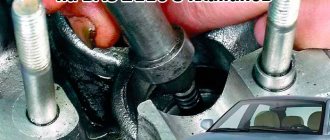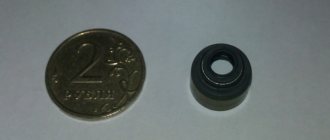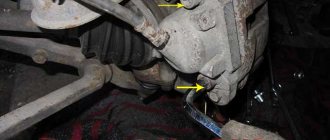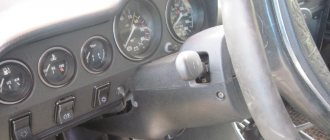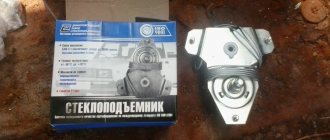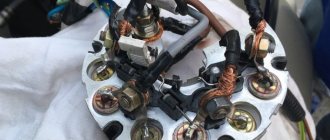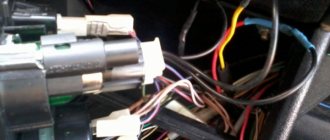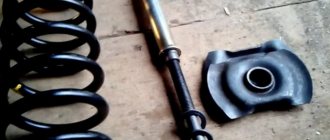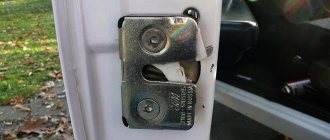If you are here, then you are the proud owner of a VAZ-2106 car that has some problems. Perhaps you enjoy watching persistent foreign cars trail behind your “six” and swallow the gray exhaust, but small, unnoticeable caps, like a candle that burned Moscow, can lead to the death of the entire engine, and therefore turn your iron horse into a modest example of real estate. The decision to fix the car was absolutely correct, and with some skill you will quickly deal with the problem.
Necessary tools and accessories
Replacing the valve stem seals of a VAZ 2106 is done directly on the car, which significantly speeds up the work, since there is no need to remove and then reinstall the cylinder head. It is enough to place the car in a place protected from dust and precipitation. Apply the handbrake and place the gearshift knob in neutral. Replacing valve stem seals on a VAZ 2106 requires a set of caps and a new head cover gasket, standard tools, accessories:
- Carrying;
- Candle key;
- Spanners 17 mm., 13 mm.;
- Hexagonal internal heads 8 mm, 10 mm, 13 mm. with a collar;
- Pliers;
- Tweezers;
- Flat screwdriver;
- 8 mm thick soft metal rod;
- Torque wrench;
- Spring compression device
- Mandrel for installing caps
- Soft wire.
Different designs of special pullers for compressing springs
Before work
The combustion chamber of the engine must be protected from foreign substances, so the cylinders need protection from oil. This is where valve stem seals, or oil seals, come into play, protecting the combustion chamber as the valve stems move. Over time, they lose elasticity and the quality of their work decreases. Nothing prevents oil from getting where it shouldn't be.
If you notice that the exhaust has become bluish and thick, soot or even soot has appeared on the spark plugs, and your VAZ-2106 eats oil like gasoline, then it is very likely that the problem with the seals has affected you too. You need to have the courage to open the hood and examine the problem. Perhaps the entire gas distribution mechanism needs to be replaced, but for now we will only talk about the caps: if we really strain ourselves, then do it systematically.
How to make your own devices
It is convenient to use a special device, since there is no need to hold it with your hands; it holds the springs compressed with a bolt. If you don’t have such a device, you can make it yourself. To do this, it is enough to have two steel square bars 10x10 mm, 300 mm long. They need to be fastened at three points, at the ends and in the middle, so that there is a gap of 12 mm between them, like rails, then the price will be much cheaper. So:
- You can attach it in any way; bolts, clamps, welding, in the fastening points between the rods you need to place metal plates 12 mm thick, which will provide the necessary gap between the rods.
- The valve stem will fit into the gap when the springs are released. To install valves, instead of a mandrel, you can use a steel tube 120 mm long, with an internal diameter of 14 mm, and a copper washer with a hole matched to the rim of the cap.
Preliminary preparation
Before starting work, it is advisable to watch the video, replacing valve stem seals on a VAZ 2106; you definitely need to thoroughly wipe the surface of the upper part of the block and the head cover. For convenience, you need to remove the air filter housing. Cover the carburetor with film or cloth to prevent dirt from entering during operation. Unscrew the spark plugs, remove the cover with the gasket.
- Set the fourth cylinder to top dead center on the compression stroke. To do this, the crankshaft rotates to a position where the intake and exhaust valves of the fourth cylinder remain closed before and after the piston passes TDC. This is determined by the clearance between the valve and the rocker arm.
- The position of the piston is determined by measuring with any rod through the spark plug hole. Check the alignment of the marks on the sprocket and the housing.
Checking whether labels match
- Use a screwdriver to bend the lock washer using a 17 mm spanner. Loosen, but do not unscrew, the nut securing the sprocket to the camshaft.
- Using a 13 mm spanner, unscrew the cap nut securing the tensioner two turns.
- Free up the chain as much as possible.
- Unscrew the nut completely and carefully remove the sprocket from the camshaft axis.
- To prevent the chain from falling off the sprocket, you need to tie it with wire and hang it together with the sprocket on the edge of the cylinder block.
Disassembly sequence
So:
- Unscrew the nine nuts holding the camshaft housing and remove it along with the shaft.
- Using a screwdriver, lift the pressure spring, pull out the pressure lever with a little force, push the spring out from under the stopper and pull it out.
- A soft wire is tightly inserted through the spark plug hole between the piston bottom and the valve so that the valve does not fall when the springs are pressed. The higher the part of the rod into which the fixing nuts are inserted, the less the springs will need to be pressed to install them.
Attention! It is not allowed to hold the valves with hard objects; there is a risk of scratching the piston or cylinder.
- A nut is screwed onto the camshaft housing mounting stud closest to the valve, as in the photo, to which a special puller or the end of a homemade device clings with a grip. It covers the stud on both sides, rests against the lower plane of the nut and rests on the upper plate of the springs.
- The valve stem with crackers is passed between the rods of the device.
Squeezing springs and removing crackers with tweezers
- We press the lever, the springs are compressed, the plate with crackers goes down, the crackers fall into the area of the narrower part of the rod, and are able to come out of the hole of the plate. You need to select them with tweezers or pliers.
Attention! It is forbidden to pull out the crackers with your hands, as you can get your fingers pinched.
- If the crackers are stuck and do not come out when the springs are significantly compressed, you need to knock them out with a weak hammer on the plate.
The device is released and removed sequentially:
- plate;
- outer spring;
- internal spring;
- inner spring lower washer;
- outer spring washer.
To remove the lower washers, you need to pry them off with a screwdriver.
- The cap is grabbed with pliers, rocked, and rises along the valve stem.
- Then a new valve stem seal is installed and the valve is assembled in reverse order.
- They are sequentially disassembled and reassembled with new valve caps for the fourth and first cylinders.
- After this, holding the sprocket, the crankshaft rotates until the pistons of the second and third cylinders reach TDC. Consistently, similar work is carried out on their valves. We can assume that the oil caps on the VAZ 2106 have been replaced.
Replacing valve stem seals on a VAZ 2106
The valve stem seals on the VAZ 2106 are replaced after approximately 30,000 kilometers. If it is not there, then it is still better to replace it after 2-3 years, because the caps dry out from old age. Find out how to replace the caps on 2106 in the article.
At the moment, in stores you can find silicone valve stem seals, which in terms of their characteristics are much better than rubber ones. Nobody talks about their durability, it's all about the elasticity of silicone. This is very important in Russian winter conditions, especially if the engine is not equipped with a pre-heater.
When to change valve stem seals on 2106
Of course, there are car enthusiasts who carefully monitor their iron horse and carry out many procedures according to schedule. However, there are very few of them, so we will pay attention to external signs.
First of all, oil consumption. Before we talk about liters, it’s worth paying attention to this. Over time, when the oil seal wears out, it turns into a filler neck, and the valve stem turns into a piston that pushes this oil. Imagine that the engine is running at 1600 rpm. This means that 800 strokes are performed per minute in one cylinder, which means the valve moves back and forth 400 times. What if there are eight such valves? In general, a lot of oil can leak through the valve stem seals.
Further - increased smoke, reduced engine power. You need to remember one simple truth - engine oil does not burn, it cokes. Only the additives burn. We all know motorcycles in which oil is mixed with gasoline. We all remember how much smoke they make. But there the fuel is diluted with oil in proportions of 1:200. Here they are much larger. That is, if you see blue smoke from the exhaust pipe, then you should think about replacing the valve stem seals. Of course, with such a mixture the engine will not develop full power, as with pure gasoline.
Tools for replacing valve stem seals 2106
First of all, you need to immediately stock up on a sufficient set of tools so that later, when the engine has already been disassembled, you don’t have to rush around looking for them. So here's a short list.
- Key for turning the crankshaft;
- Rassukhaka;
- Set of flat blade screwdrivers, different widths;
- Set of keys and sockets;
- Tweezers;
- Valve cover gasket;
- If you plan to adjust the valves, then a feeler gauge with a thickness of 0.15 mm is required;
- Tin rod about 1 cm thick;
- Puller for valve stem seals.
Preparation for replacing valve stem seals of VAZ 2106
We will consider replacing valve stem seals on a VAZ 2106 without removing the head, so it will be both easier and more difficult. The simplicity lies in the fact that there is no need to dismantle the head. And the difficulty, which is also logical, is not to drop the valve into the cylinder.
First, unscrew the chain tensioner, then you will need to tighten it. This is necessary so that you can remove the camshaft gear without any obstacles. Next, remove the valve cover and mark the position of the gear on the chain. This is necessary in order not to set marks later. In principle, you don’t have to do this, but it’s easier this way.
Now we unscrew the gear, remove it and secure the chain so that it does not fall into the crankcase. If this happens, you will have to remove the pan, radiator, front cover and then adjust the timing. In general, it’s not very pleasant.
Now remove the camshaft housing. Next, we unscrew the spark plugs to make it easier to rotate the crankshaft. We hold the chain tight and set the piston of the first cylinder to top dead center (TDC). This is why you need a key to rotate the crankshaft. To get exactly to TDC, you need to align the mark on the crankshaft pulley with the last mark on the front cover along the way.
Replacing valve stem seals on a VAZ 2106
Now we install the sealant on any valve of the first or fourth cylinders, then insert a tin rod into the spark plug hole and clamp it, pressing on the sealant. This is done so that the valve does not punch a hole in the piston bottom. Now we jerkly press on the cracker so that the spring compresses, carefully remove the crackers with tweezers. It is important not to lose them, otherwise you will have to run to the store.
Then use a puller to remove the old cap and press on a new one. Now we compress the spring again and install the crackers. We do this with each valve in the first and fourth cylinders.
Now we rotate the crankshaft 180 degrees and set the pistons of the second and third cylinders to top dead center. We carry out the same operations with valves. Then we install the camshaft and housing in place. The procedure for tightening the camshaft housing bolts is shown in the figure. Now we combine the marks on the camshaft gear and the chain; if adjustment of the valves is required, then we carry it out. Then we put all the parts in place.
Video: replacing caps on a VAZ 2106
Assembly order
Pressing in valve stem seals using a bushing
- The valve stem, oil seal and cap are lubricated with engine oil; the valve cap corresponding to the valve is placed on the stem with the oil seal facing up. It descends down the stem, where it is pressed tightly against the hole with the valve guide.
- The end of the mandrel is pressed against the rim of the cap, by lightly tapping the top of the mandrel with a hammer, the cap is pushed into the hole until it stops. The cost of a mistake in case of strong impacts, damage to the oil seal or cap, will have to be replaced. The springs are installed in the reverse order of disassembly.
Attention! After installing the springs and removing the device for compressing the springs, you need to remove the plate from the spark plug hole and tap the end of the rod with a hammer so that the crackers sit in their place. This must be done carefully; if the crackers are positioned incorrectly, the springs may pop out.
Procedure for tightening the camshaft cover nuts
The camshaft cover, as required by the instructions, is pressed with a torque wrench with a force of 8 kg/m. tightening the nuts in the required sequence.
Recommendations for troubleshooting
If, when starting the engine, the indicator of too low engine oil level in the crankcase comes on in your car (it is only present in cars with a high front panel; in cars with a low one, the indicator only has an emergency oil pressure sensor), you must first turn off the engine immediately. Then you need to inspect the power unit for leaks. If they are not there, then after 20 minutes you need to check the lubricant level in the crankcase using a dipstick. If the level is normal (between the min and max marks), you should check the oil level sensor. It is located next to the oil filter. It is always much easier and cheaper to replace a faulty sensor than to disassemble the power unit due to an imaginary breakdown.
To replace the caps you will need the following tools:
- a device used to press the caps (mandrel);
- device for compressing valve springs;
- pliers;
- tweezers;
- a tin rod with a diameter of approximately 8 mm and a length of at least 20 cm.
In addition, a standard set of keys will come in handy.
How to replace valve stem seals on a VAZ-2106
If you are here, then you are the proud owner of a VAZ-2106 car that has some problems. Perhaps you enjoy watching persistent foreign cars trail behind your “six” and swallow the gray exhaust, but small, unnoticeable caps, like a candle that burned Moscow, can lead to the death of the entire engine, and therefore turn your iron horse into a modest example of real estate. The decision to fix the car was absolutely correct, and with some skill you will quickly deal with the problem.
